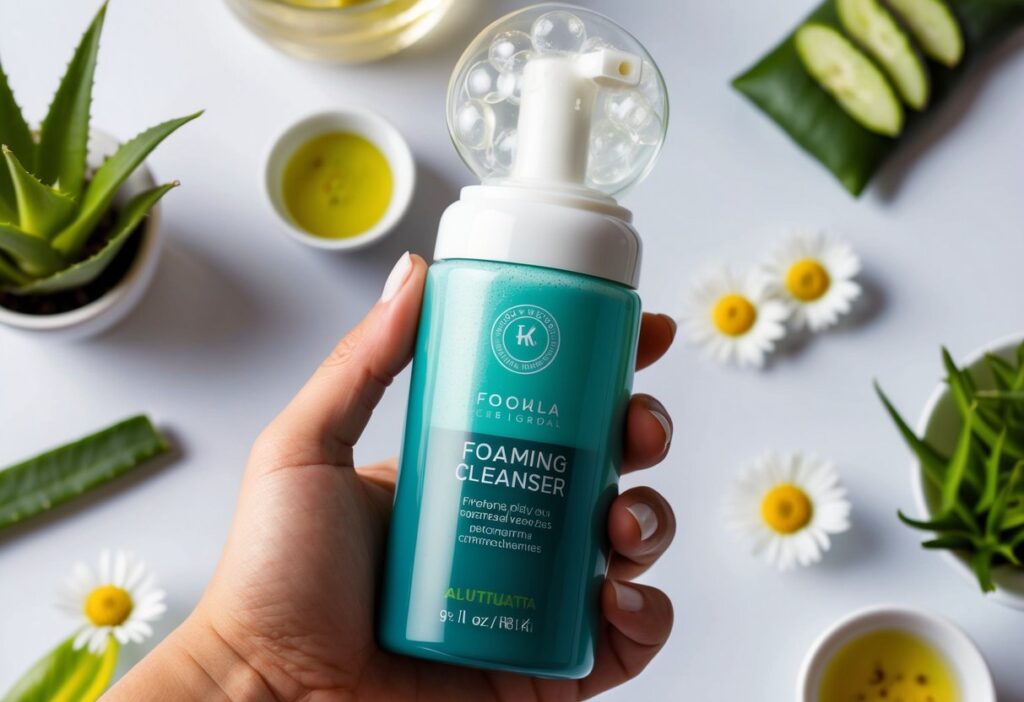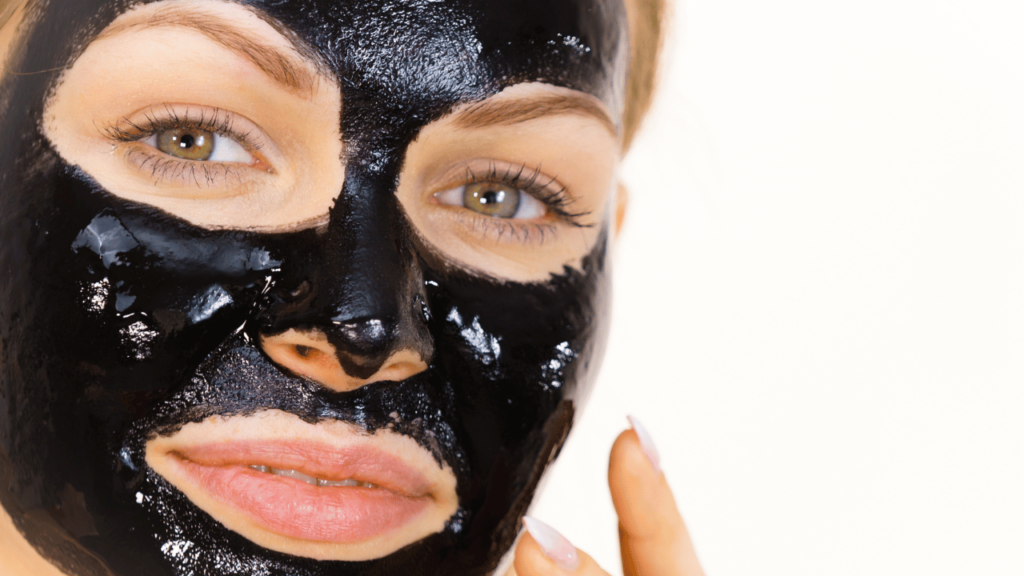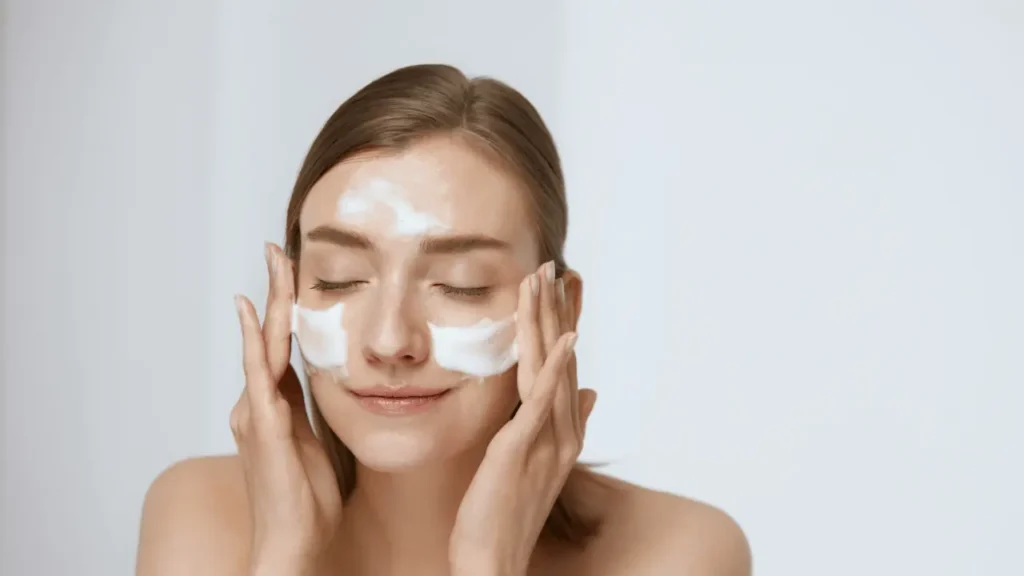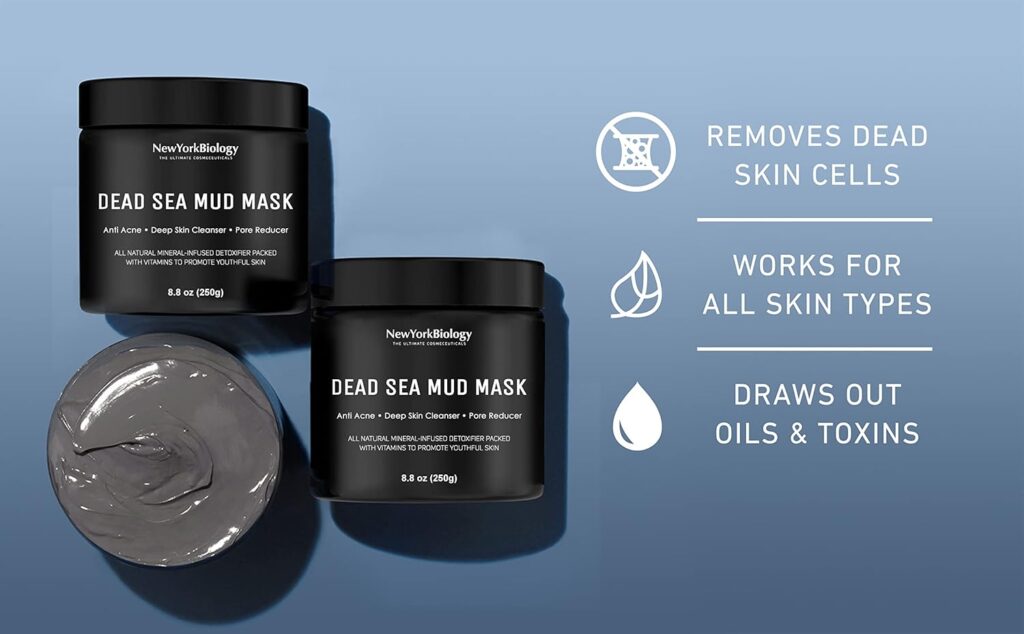When it comes to skincare, finding the right cleanser can feel overwhelming. Foaming cleansers have become popular for their ability to remove dirt and excess oil effectively. They provide a refreshing wash that leaves our skin feeling clean and revitalized, making them a great choice for many skin types.

Table of Contents
We all want a product that works well, but it’s important to choose one that suits our needs. Foaming cleansers come in various formulas, often designed to target specific skin concerns. Knowing what to look for can help us make the best choice for a healthy skincare routine.
In this guide, we will explore everything you need to know about foaming cleansers. From how they work to which ingredients are beneficial, we’ll equip ourselves with the knowledge to choose a cleanser that keeps our skin looking and feeling its best.
What Are Foaming Cleansers?
Foaming facial cleansers are water-based facial cleansers that lather into a foam when applied to the skin. They work by using surfactants—compounds that help to lift and remove dirt, oil, and impurities from the skin’s surface. The foaming action is what sets these cleansers apart from gel or cream cleansers, offering a refreshing and lightweight texture that many find appealing, especially for those with oily or combination skin.
Unlike cream or oil-based cleansers that are typically heavier and designed to hydrate, foaming cleansers focus on deep cleansing, making them ideal for those prone to oil buildup, acne, or clogged pores.
How Foaming Cleansers Work
The Science Behind The Lather
When we mix foaming facial cleansers with water, they produce a thick lather. This lather is formed by a group of ingredients called surfactants. Surfactants lower the surface tension of water, allowing it to spread and penetrate better. As we massage the cleanser onto our skin, the bubbles trap dirt, oil, and impurities.
The texture of the foam feels nice and provides a sense of cleanliness. The tiny bubbles lift away grime, making rinsing easy and effective. Using foaming cleansers can feel refreshing, leaving our skin clean and revitalized.
Role of Surfactants
Surfactants are the key players in how foaming cleansers work. They are made of two parts: a hydrophilic (water-attracting) part and a hydrophobic (water-repelling) part. This unique structure allows them to bond with both water and oil.
When we apply the cleanser, surfactants attach to oil and dirt on our skin. The hydrophobic tail grabs hold of oils, while the hydrophilic head stays connected to water. As we rinse, the surfactants help wash away the oil and impurities, leaving our skin clean.
Different foaming cleansers may use various types of surfactants. Some may be gentle, making them suitable for sensitive skin, while others target oil and debris more aggressively.
pH Balance Considerations
The pH level of foaming facial cleansers is important for our skin health. Most cleansers are formulated to be slightly acidic, typically around pH 5 to 7. This pH level helps maintain the skin’s natural barrier.
Using a product with a pH that is too high can disrupt this balance. It may lead to dryness or irritation. We should look for cleansers that complement our skin type.
On the other hand, maintaining a proper pH can enhance the effectiveness of the surfactants. A balanced pH allows for gentle cleansing while preserving moisture, contributing to healthy and radiant skin.
Benefits Of Using Foaming Cleansers
1. Effective Dirt And Oil Removal
Foaming cleansers excel at lifting away dirt, makeup, and excess oil. The bubbly texture allows them to bind to impurities, making it easier to wash them away. For those of us with oily skin, this feature is particularly helpful.
By using foaming cleansers, we can achieve a deep clean without over-drying our skin. Their ability to remove oil and debris helps prevent clogged pores, reducing the chances of breakouts. This cleansing method leaves our skin feeling refreshed and rejuvenated.
2. Gentle Yet Thorough Cleansing
While foaming cleansers provide an effective clean, they also remain gentle on the skin. Many are formulated with soothing ingredients like glycerin and niacinamide. These components help maintain moisture levels, preventing skin irritation.
We can also benefit from the mild exfoliating properties of some foaming cleansers. They can help remove dead skin cells without the harshness of scrubs, making them ideal for daily use. This blend of thorough and gentle cleansing makes foaming cleansers a great choice for our skin.
3. Suitable For Oily And Combination Skin
For those of us with oily or combination skin, foaming cleansers are an excellent option. Their formulation specifically targets excess oil, helping to keep our skin balanced. We can enjoy the deep cleaning without the worry of stripping our skin’s natural oils.
These cleansers help manage shine and reduce the appearance of large pores. When we choose the right foaming cleanser, we can enjoy a fresh, matte look throughout the day. They provide just the right amount of cleansing power to maintain our skin’s health.
4. Refreshing And Invigorating Feel
Using a foaming cleanser can be a refreshing part of our daily routine. The airy lather feels light and invigorating on our skin. Many foaming cleansers have added botanical ingredients that enhance this refreshing experience.
After rinsing, our skin often feels clean, smooth, and revitalized. This energizing effect can make our cleansing routine feel more enjoyable. We can look forward to starting or ending our day with a burst of freshness that uplifts our spirits.
Key Ingredients In Foaming Cleansers
When choosing a foaming cleanser, it’s important to know which ingredients make them effective. We can break these down into several key categories that help cleanse, hydrate, and soothe our skin.
Gentle Surfactants (e.g., Cocamidopropyl Betaine)
Gentle surfactants are the foundation of foaming cleansers. They help create that lovely lather we enjoy while cleaning our skin. Cocamidopropyl Betaine is a popular option because it’s derived from coconuts.
It works effectively while being mild on the skin. These surfactants help lift dirt and oil without stripping our skin of its natural moisture.
Using cleansers with gentle surfactants ensures we get a good clean without irritation, making them a great choice for various skin types, including sensitive skin.
Hydrating Agents (e.g., Glycerin)
Hydration is key in any skincare routine, so we want to look for hydrating agents in foaming cleansers. Glycerin is a standout ingredient here.
It attracts moisture to our skin, helping to keep it supple and soft. When we use products with glycerin, our skin feels refreshed after cleansing.
These agents work hand in hand with surfactants, ensuring that while we cleanse, we also maintain our skin’s natural moisture levels. This balance is especially important to prevent dryness.
Soothing Ingredients (e.g., Aloe Vera, Chamomile)
Foaming cleansers often include soothing ingredients to calm our skin. Aloe Vera is one of the most well-known ingredients for its calming properties.
It can reduce redness and irritation, making it perfect for post-cleansing care. Chamomile also plays a significant role in providing a gentle touch. Its anti-inflammatory effects can help soothe our skin after a long day.
These soothing ingredients make foaming cleansers more enjoyable, especially after a workout or when our skin feels stressed.
Active Ingredients For Specific Skin Concerns
Some foaming cleansers incorporate active ingredients that target specific skin concerns. For instance, salicylic acid is great for acne-prone skin. It helps clear pores and prevents breakouts.
On the other hand, hyaluronic acid can help keep our skin hydrated while effectively cleansing. Ceramides are also important as they support our skin barrier, ensuring that we don’t lose essential moisture during cleansing.
By choosing foaming cleansers with these active ingredients, we can address specific concerns while still enjoying a refreshing cleanse.
Knowing these key ingredients can help us select the best foaming cleanser for our needs.
How To Use Foaming Cleansers Effectively
Using foaming cleansers correctly can enhance their effectiveness in our skincare routine. We need to focus on the proper application techniques, how often to use them, and how to fit them seamlessly into our daily regimen.
Proper Application Technique
Using a foaming cleanser is simple, but there are a few steps to ensure you get the best results:
- Wet Your Face: Begin by splashing your face with lukewarm water to open up your pores.
- Apply the Cleanser: Dispense a small amount of cleanser into your hands and work it into a foam by rubbing your palms together.
- Massage Gently: Using your fingertips, massage the foam into your skin in circular motions for about 30-60 seconds. Focus on areas prone to oil buildup, such as the forehead, nose, and chin.
- Rinse Thoroughly: Rinse your face with lukewarm water to remove all traces of the cleanser.
- Pat Dry: Gently pat your skin dry with a clean towel.
Frequency Of Use
We can use foaming cleansers daily, but it’s essential to listen to our skin. If we have oily or acne-prone skin, using it twice a day—once in the morning and once at night—can be beneficial. This helps remove excess oil and impurities.
For those with dry or sensitive skin, we might want to limit our use to once daily, preferably at night. This way, we can remove makeup and dirt accumulated throughout the day without stripping our skin’s natural moisture.
Adjusting our usage based on how our skin feels can also make a big difference. If our skin feels dry or irritated, we can cut back or switch to a gentler formula.
Incorporating Into Your Skincare Routine
Incorporating a foaming cleanser into our skincare routine is simpler than it seems. First, we should use it after our makeup remover or micellar water, as this ensures that all traces of makeup are gone.
After cleansing, we can follow up with a toner to balance our skin’s pH. Next, applying serums or treatments is a great way to address specific concerns, like acne or dryness.
Finally, incorporating a moisturizer is crucial. It helps lock in hydration after cleansing. By fitting our foaming cleanser into this sequence, we maximize its benefits for clean and healthy skin.
Choosing The Right Foaming Cleanser
Finding the right foaming cleanser can make a big difference in our skincare routine. It’s important to match the product with our skin type and specific needs. Let’s explore the best foaming cleansers tailored for various skin types.
For Oily Skin
When we have oily skin, we often deal with excess sebum, which can lead to shine and breakouts. A foaming cleanser with strong surfactants is ideal. These ingredients help remove oil and dirt effectively.
Key ingredients to look for:
- Salicylic Acid: This helps to unclog pores.
- Tea Tree Oil: Known for its antibacterial properties.
- Clay: This can absorb excess oil.
Using a foaming cleanser 1-2 times a day can help keep our skin fresh. Look for options that are non-comedogenic to prevent clogged pores.
For Combination Skin
Combination skin means we might have oily areas, like the T-zone, and dry patches elsewhere. Choosing a gentle foaming cleanser is crucial for us. It should cleanse without stripping the skin of its natural oils.
Recommended ingredients include:
- Aloe Vera: Hydrates while cleansing.
- Glycerin: Keeps our skin moisturized.
- Mild Surfactants: These will cleanse without irritation.
Using a balanced foaming cleanser will help maintain our skin’s natural balance. We may also want to consider using a toner after cleansing to help refine our pores further.
For Sensitive Skin
If our skin is sensitive, we need to be extra careful with foaming cleansers. Harsh ingredients can cause irritation and redness.
Opt for a foaming cleanser that is fragrance-free and hypoallergenic.
Look for soothing ingredients like:
- Chamomile Extract: Known for its calming effects.
- Oat Extract: This can help reduce irritation.
- Mild, non-irritating surfactants: These will cleanse without damage.
A gentle cleanser will help us avoid flare-ups while keeping our skin clean. We should also patch test new products to ensure they don’t cause irritation.
For Acne-Prone Skin
For those of us dealing with acne, the right foaming cleanser can significantly improve our skin. We need products that effectively treat breakouts without being overly harsh.
Important ingredients to consider:
- Benzoyl Peroxide: Targeted for its acne-fighting properties.
- Salicylic Acid: Penetrates pores to prevent breakouts.
- Witch Hazel: Helps with inflammation.
Using a foaming cleanser with these ingredients 1-2 times a day can help keep our skin clear. Be careful not to over-cleanse, as that can lead to irritation and worsened acne.
Comparing Foaming Cleansers To Other Types

When we explore the differences between foaming cleansers and other types, we find some interesting features. Each type has its own texture and benefits, catering to various skin types and preferences. Let’s break down how foaming cleansers stack up against gel, cream, and oil cleansers.
Foaming vs. Gel Cleansers
Foaming cleansers and gel cleansers both have a lightweight feel. However, foaming cleansers create a rich lather, making them feel fresh and invigorating. This can be appealing for those of us who enjoy a bubbly experience when cleansing.
Gel cleansers, on the other hand, are typically thicker and can be gentler on sensitive skin. They offer hydration while cleaning, which is great for those with dry skin. While both types remove dirt and oil effectively, foaming cleansers might suit us better if we prefer a squeaky-clean feeling.
Read More:- The Benefits of Gel Cleansers, Ingredients, and Usage Tips
Foaming vs. Cream Cleansers
Cream cleansers are often rich and moisturizing. They can form a thick layer that nourishes our skin as we cleanse. This is particularly helpful for those with dry or sensitive skin.
Foaming cleansers, being lightweight, can feel refreshing. They are excellent when we want to remove makeup or excess oil quickly. If we have oily or combination skin, a foaming cleanser might help keep breakouts at bay, while a cream cleanser could suffice for dry areas.
Foaming vs. Oil Cleansers
Oil cleansers offer a unique experience. They break down heavy makeup and impurities effectively. If we often wear makeup, an oil cleanser can be a good first step in our routine.
Foaming cleansers, while effective at removing dirt, might not be as efficient with stubborn makeup. However, they leave a clean and refreshed feeling afterward. For us, choosing between these depends on our specific needs: quick daily cleansing or thorough makeup removal.
Top Recommended Foaming Cleansers for All Skin Types

When looking for the right foaming cleanser, it’s important to consider skin type and budget. Here, we’ll share our top recommendations tailored for oily skin, combination skin, budget-friendly options, and some luxurious picks.
Best foaming cleansers for oily skin
For those of us with oily skin, a foaming cleanser can effectively remove excess oil and prevent breakouts. We recommend PanOxyl Acne Foaming Wash. This product contains 10% benzoyl peroxide, which targets acne-causing bacteria while deep-cleaning pores.
Another great option is the SkinCeuticals LHA Cleansing Gel. This cleanser includes a blend of salicylic acid and glycolic acid, helping to exfoliate and refine skin texture. Both of these products leave our skin feeling fresh without over-drying, making them ideal for those battling shine.
Best foaming cleansers for combination skin
Combination skin needs a gentle yet effective cleanser to balance various areas. We love KraveBeauty Matcha Hemp Hydrating Cleanser. It contains matcha, which is rich in antioxidants, paired with hemp seed oil that nourishes without clogging pores.
The Cetaphil PRO Foaming Face Wash is another fantastic choice. This cleanser is designed for sensitive and combination skin, removing makeup and impurities without disturbing our skin’s moisture barrier. Both options help us maintain a healthy balance and soft feel.
Best Budget-Friendly Foaming Cleansers
Sticking to a budget doesn’t mean compromising on quality. Garnier Micellar Foaming Face Wash is our go-to, priced around $10. It effectively cleanses our skin while keeping it hydrated, thanks to its micellar water base.
Another excellent budget pick is Cleansing Foam by Neutrogena. This product is formulated specifically for oily skin and removes dirt and makeup efficiently. Both of these affordable cleansers make our skincare routines effective and wallet-friendly.
Luxury Foaming Cleansers
For those who enjoy a touch of luxury, we have some wonderful options. The Estée Lauder Perfectly Clean Multi-Action Foam Cleanser is both a cleanser and a purifying mask. It’s gentle yet powerful, perfect for pampering our skin.
We also recommend the Tatcha The Deep Cleanse. This luxurious product contains natural exfoliants and is suitable for all skin types. It’s infused with Japanese luffa fruit for gentle exfoliation, leaving our skin feeling rejuvenated and fresh.
These recommendations cater to various needs, ensuring we find the perfect match for our skin type and budget!
Are Foaming Cleansers Safe for Daily Use?
Yes, foaming cleansers can be used daily, but it’s important to select a formula that suits your skin type and needs. Overuse or choosing a cleanser that is too harsh can lead to dryness, irritation, and damage to the skin barrier. If you notice your skin becoming dry or irritated, consider reducing the frequency of use or switching to a more hydrating formula.
Expert Tips for Balancing Your Skincare Routine
- Use a hydrating toner or moisturizer after cleansing to replenish the skin’s moisture.
- If your skin feels tight after using a foaming cleanser, switch to a gentler formula or reduce usage to once a day.
Potential Drawbacks And How To Mitigate Them

Over-Drying Concerns
One common issue with foaming cleansers is that they can lead to over-drying skin. This happens because these products often contain sulfates or strong detergents. When our skin loses moisture, it can feel tight and uncomfortable.
To prevent this, we can look for gentle formulas labeled as hydrating. Ingredients like glycerin or hyaluronic acid can help maintain moisture.
Another good tip is to avoid using foaming cleansers more than twice a day. Also, following cleansing with a moisturizer helps replenish hydration.
Irritation In Sensitive Skin
Foaming cleansers might not be the best choice for everyone, especially those with sensitive skin. These products can cause irritation, redness, or a burning sensation. Fragrances and harsh ingredients can contribute to these reactions.
We should choose foaming cleansers that are fragrance-free and specifically formulated for sensitive skin. Checking for calming ingredients like aloe vera or chamomile can be a smart move.
Always performing a patch test can help us see how our skin reacts before using a new product.
Tips For Minimizing Negative Effects
To enjoy foaming cleansers without the drawbacks, we can adopt a few helpful practices. First, it’s wise to use lukewarm water rather than hot water for cleansing. Hot water can strip our skin of its natural oils.
Using a soft washcloth or our hands gently can also reduce irritation. We should consider alternating foaming cleansers with cream-based or oil-based cleansers. This allows our skin to retain moisture and helps avoid irritation.
Lastly, never skip moisturizer. Applying it right after cleansing can help lock in hydration and keep our skin feeling soft and balanced.
Conclusion

Here are some key benefits we enjoy with foaming cleansers:
- Deep Cleansing: They penetrate our pores to remove buildup.
- Oil Control: Perfect for those of us with oily or acne-prone skin.
- Gentle Exfoliation: Many formulas gently slough off dead skin cells.
When choosing a foaming cleanser, skin type is important. We should consider if we need hydration or a formula that fights acne.
For best results, we follow simple steps:
- Wet Our Face: This helps open our pores.
- Apply Cleanser: A small amount is usually enough.
- Rinse Well: Make sure no residue is left behind.
With so many options available, it’s easy to find a foaming cleanser that suits our needs. We can enjoy refreshed and clear skin every day!
FAQs
1. Are foaming cleansers good for dry skin?
While foaming cleansers are typically recommended for oily and combination skin due to their ability to control excess oil, some formulations are gentle enough for dry skin. Look for foaming cleansers that include hydrating ingredients like glycerin or hyaluronic acid to prevent dryness and tightness after use.
2. Can foaming cleansers remove makeup effectively?
Foaming cleansers can remove light makeup and impurities from the skin, but they may struggle with waterproof or heavy makeup. For a thorough cleanse, especially with long-wear or waterproof makeup, it’s best to use a makeup remover or cleansing oil before applying the foaming cleanser.
3. How often should I use a foaming cleanser?
For most skin types, it’s recommended to use a foaming cleanser twice a day, in the morning and at night. However, if you notice dryness or irritation, consider reducing usage to once daily or alternating with a gentler cleanser.
4. What’s the difference between foaming and gel cleansers?
Foaming cleansers are generally better for oily and acne-prone skin as they provide a deeper clean and more effective oil control. Gel cleansers are a bit gentler and often work well for those with sensitive or combination skin. Both are water-based but differ in texture and feel.
5. Do foaming cleansers help with acne?
Yes, foaming cleansers are especially effective for acne-prone skin because they help remove excess oil, dirt, and bacteria from the pores. Many foaming cleansers also contain acne-fighting ingredients like salicylic acid, which penetrates pores to reduce breakouts and clear blackheads.
6. Should I avoid foaming cleansers if I have sensitive skin?
Not necessarily. Sensitive skin can still benefit from foaming cleansers as long as they are formulated with gentle ingredients, like chamomile or aloe vera, and free from harsh chemicals and fragrances. Look for products labeled as “gentle” or “for sensitive skin” and consider testing a small area first to ensure it doesn’t cause irritation.
7. Is it normal for my skin to feel tight after using a foaming cleanser?
A tight feeling after cleansing can sometimes indicate that the cleanser is too harsh or stripping away too much moisture. If you experience tightness, try switching to a milder foaming cleanser with hydrating ingredients, or limit its use to once daily. Following up with a moisturizer can also help restore hydration.
8. Are foaming cleansers suitable for morning and night routines?
Yes, foaming cleansers can be used both in the morning and at night. In the morning, they help refresh the skin by removing oils produced overnight, and in the evening, they cleanse away dirt, oil, and impurities accumulated throughout the day. If your skin feels overly dry, consider using a gentler cleanser in the morning.









Pingback: Types of Cleansers for all Skin Types - Productsforme
Pingback: The Benefits of Gel Cleansers, Ingredients, and Usage Tips - Productsforme
Pingback: Anua Cleanser vs COSRX Cleanser: Which K-Beauty Cleanser is Best for you?
Pingback: What Are Clay Cleansers and How Do They Work?
Pingback: How to Choose the Best Cleanser for Oily Skin?
Pingback: The Ultimate Guide to Facial Cleansers: Types, Benefits, and How to Choose the Best One